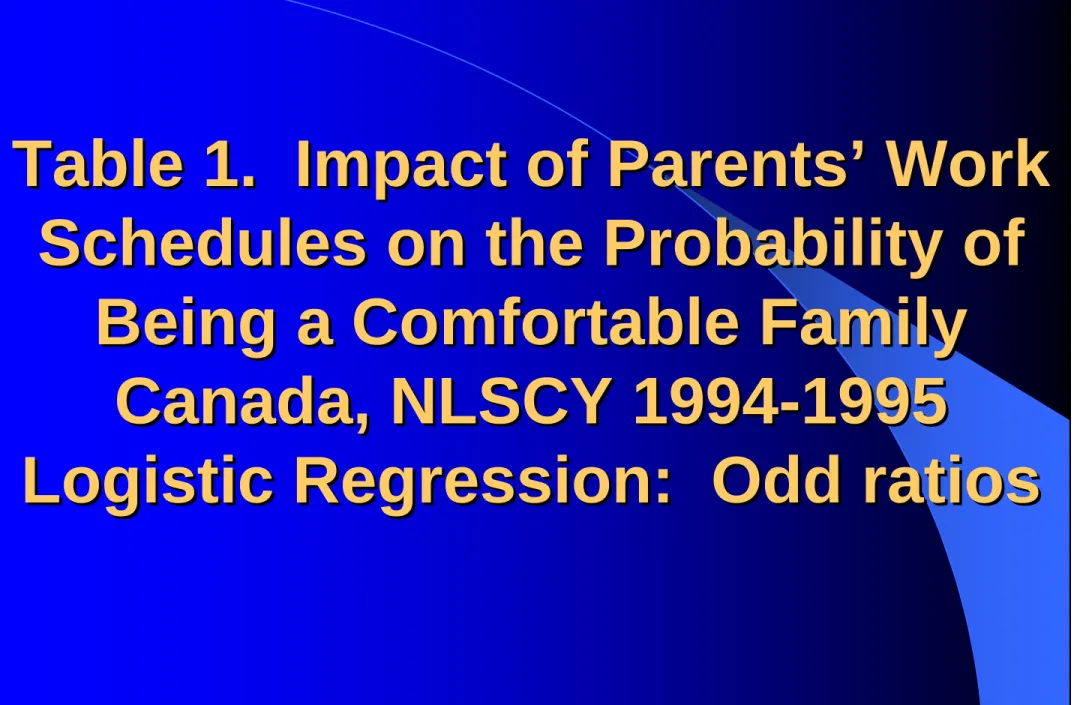Temps parental et temps professionnel:
la complémentarité des horaires
de travail des parents
Evelyne Lapierre-Adamcyk, Nicole Marcil-Gratton et
Céline Le Bourdais
R
Réépartition des famillespartition des familles biparentalesbiparentales avec enfants de avec enfants de moins de 12 ans selon le r
moins de 12 ans selon le réégime et l'horaire de travail gime et l'horaire de travail des parents, Canada, ELNEJ 1994
des parents, Canada, ELNEJ 1994--19951995
pl.rég.-inactif 12% pl.aty.-inactif 11% 2 pl.rég. 17% pl.part.-2rég. 7% pl.part.-rég.aty. 12% 2 pl.-1rég.1aty. 19% 2 pl.-aty.nonconc. 4% 2 pl.-aty.conc. 4% 2 inactifs 3% autres 3% pl.part.-2aty.nonconc. 5% pl.part.-2aty.conc. 3% 26 % AU MOINS UN INACTIF 44% DEUX PARENTS À PLEIN TEMPS 27% UN À PLEIN TEMPS, UN À TEMPS PARTIEL
pl.rég.-inactif 12% pl.aty.-inactif 11% 2 pl.rég. 17% pl.part.-2rég. 7% pl.part.-2 aty.conc. 3% pl.part.-2 aty.nonconc. 5% pl.part.-rég.aty. 12% autres 3% 2 inactifs 3% 2 pl.-1rég.1aty. 19% 2 pl.-aty.nonconc. 4% 2 pl.-aty.conc. 4% R
Réépartition des famillespartition des familles biparentalesbiparentales avec enfants de avec enfants de moins de 12 ans selon le r
moins de 12 ans selon le réégime et l'horaire de travail gime et l'horaire de travail des parents, Canada, ELNEJ 1994
des parents, Canada, ELNEJ 1994--19951995
58 % AU MOINS UN HORAIRE ATYPIQUE
Distribution of
Distribution of twotwo--parentparent familiesfamilies by labour force participation by labour force participation and income adequacy
and income adequacy, Canada, NLSCY 1994, Canada, NLSCY 1994--19951995
03 21 49 27 0 5 31 47 17 9 33 34 24 1 13 45 33 7 2 34 42 18 4 12 67 18 3 1 9 30 42 18 0% 20% 40% 60% 80% 100%
2 full time F.full-M.part. M. full-F.part F.Full-M.unemp..
2 part time 2 unempl. Total Labour force participation
Very Comfortable Comfortable Tight Budget Insufficient Very insufficient Sum of "tight", "insufficient" and "very insufficient" 24 36 42 59 78 97 40
Distribution of
Distribution of families where bothfamilies where both parentsparents workwork full time byfull time by work work schedules and income adequacy
schedules and income adequacy, Canada, NLSCY 1994, Canada, NLSCY 1994--19951995
2 18 47 33 3 21 51 25 2 21 54 24 7 25 42 26 4 33 48 15 3 21 49 27 0% 10% 20% 30% 40% 50% 60% 70% 80% 90% 100%
Both regular F. reg. M. atypical
M. reg. F. aty. Both aty. Ident. Both aty. Diff. Total Very Comfortable Comfortable Tight Budget Insufficient Very insufficient Work Schedules Sum of "tight", "insufficient" and " very insufficient"
Distribution of
Distribution of families where the father worksfamilies where the father works full timefull time and the and the mother works
mother works part time bypart time by work schedules and income adequacywork schedules and income adequacy, , Canada NLSCY 1994 Canada NLSCY 1994--19951995 2 3 28 48 20 06 30 49 15 06 29 48 17 6 29 51 14 5 40 40 15 05 31 47 17 0% 10% 20% 30% 40% 50% 60% 70% 80% 90% 100% Both regular F. reg. M. atypical M. reg. F. aty. Both aty. Ident. Both aty. Diff. Total Work Schedules Very Comfortable Comfortable Tight Budget Insufficient Very insufficient sum of "tight", "insufficient" and "very insufficient"
Distribution of
Distribution of families wherefamilies where one parentone parent only is working only is working by
by work schedules and income adequacywork schedules and income adequacy, , Canada, NLSCY 1994 Canada, NLSCY 1994--19951995 2 10 46 34 8 2 19 43 31 6 2 23 45 30 1 2 28 52 15 3 2 16 45 32 7 0% 20% 40% 60% 80% 100% F. reg. M. unemp. F. aty. M. unempl. M. reg. F. unempl. M. aty. F. uempl. Total Work Schedules Very Comfortable Comfortable Tight Budget Insufficient Very insufficient sum of "tight", "insufficient" and "very insufficient" 58 63 70 82 62
Table 1. Impact of Parents
Table 1. Impact of Parents
’
’
Work
Work
Schedules on the Probability of
Schedules on the Probability of
Being a Comfortable Family
Being a Comfortable Family
Canada, NLSCY 1994
Canada, NLSCY 1994
-
-
1995
1995
Logistic Regression: Odd ratios
Model A Model Ba Model Cb Families where both parents work full-time
2 regular schedules 1.000 1.000 1.000 1 regular schedule-1 irregular schedule 0.791 *** 0.847 * 0.983 2 atypical schedules that are the same 0.495 *** 0.565 ** * 0.815 2 atypical. schedules - not the same 0.389 *** 0.442 ** * 0.674 ***
Families where the father works full-time and the mother part-time 2 parents-regular schedules 1.000 1.000 1.000 1 regular schedule, 1- atypical 0.859 0.891 1.000 2 atypical schedules, the same 0.915 1.060 1.270 2 atypical schedules, not the same 0.603 *** 0.663 ** * 0.766 * Level of significance: * p < 0.05; ** p < 0.01; *** p < 0.001
aControlled for age of children, mother’s age and educational level, type of family (intact or step).
b Controlled for age of children, mother’s age and educational level, type of family (intact or step), parents’
